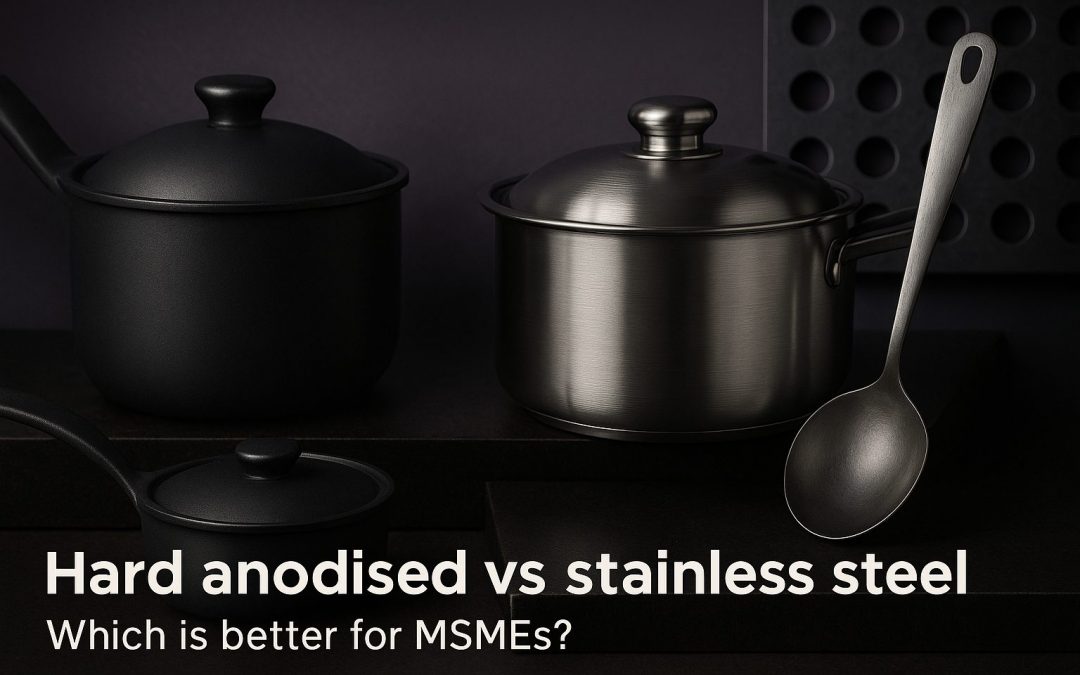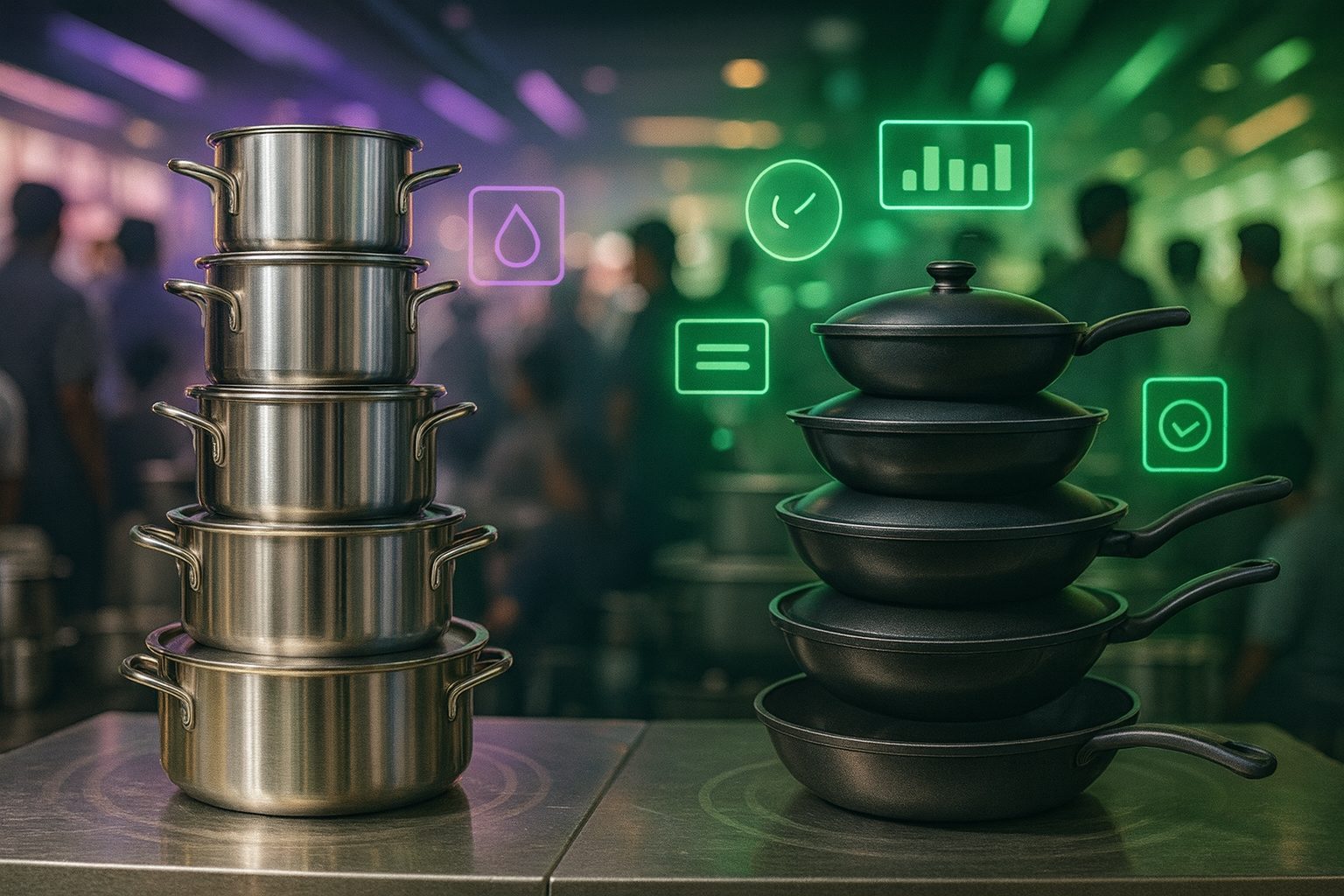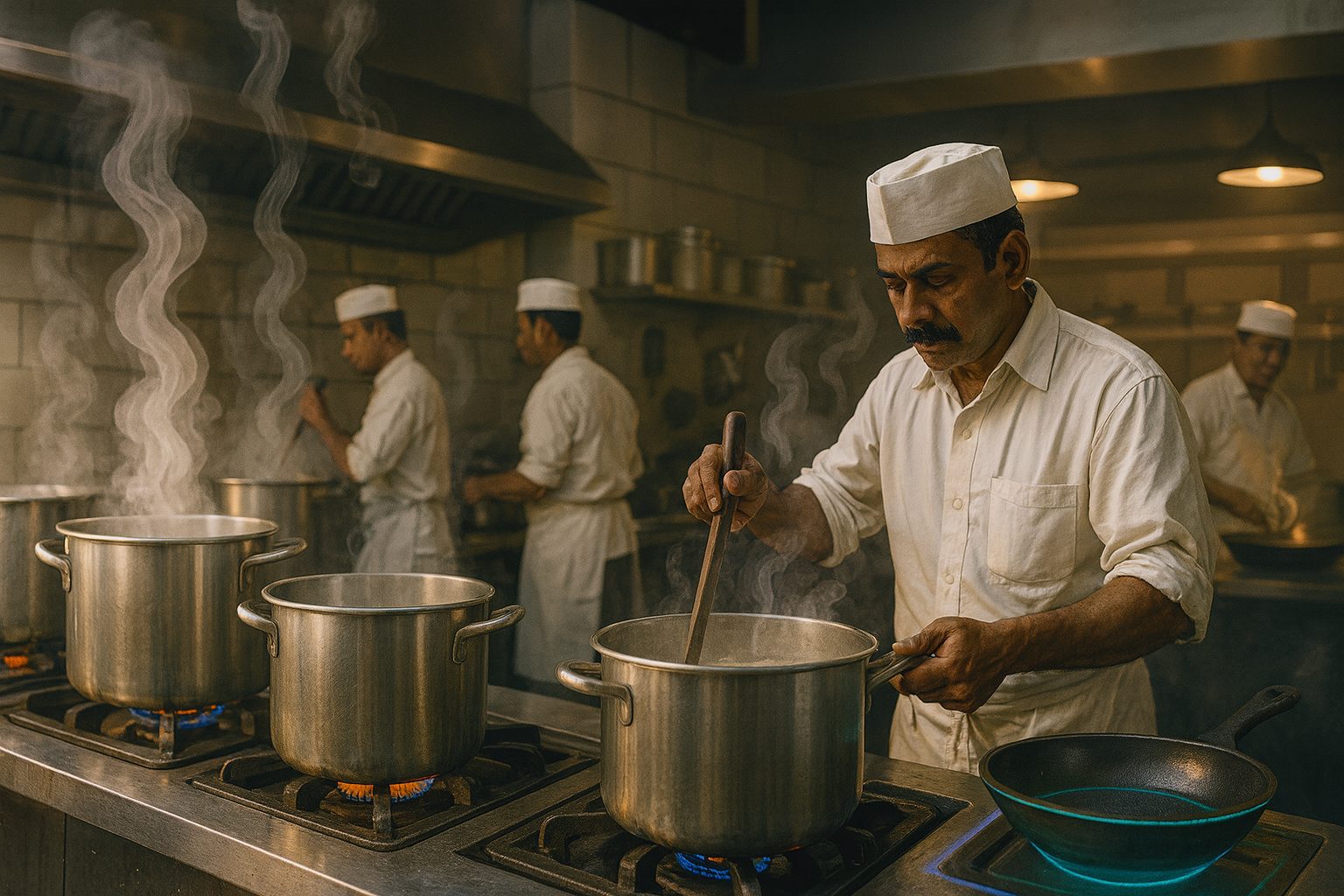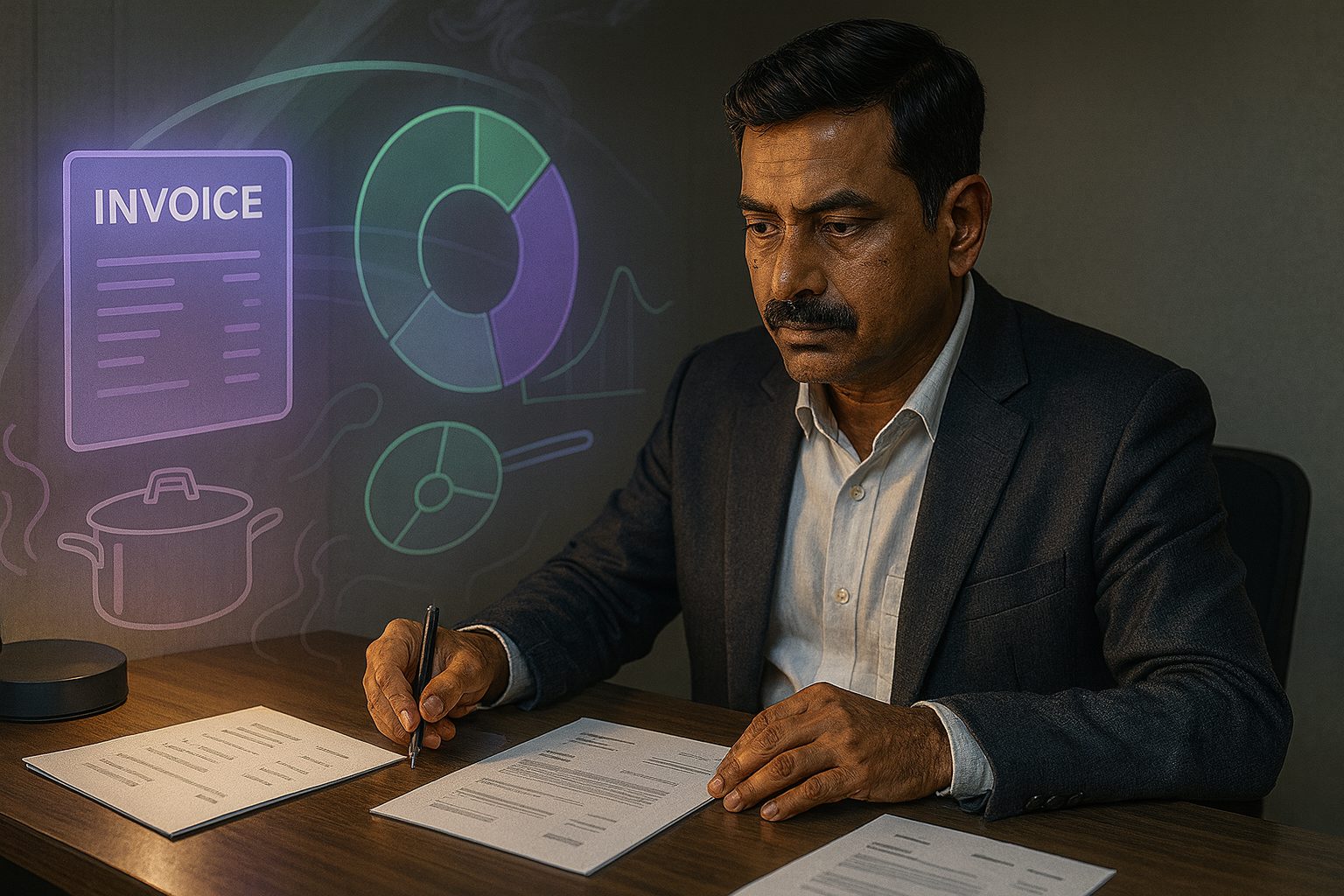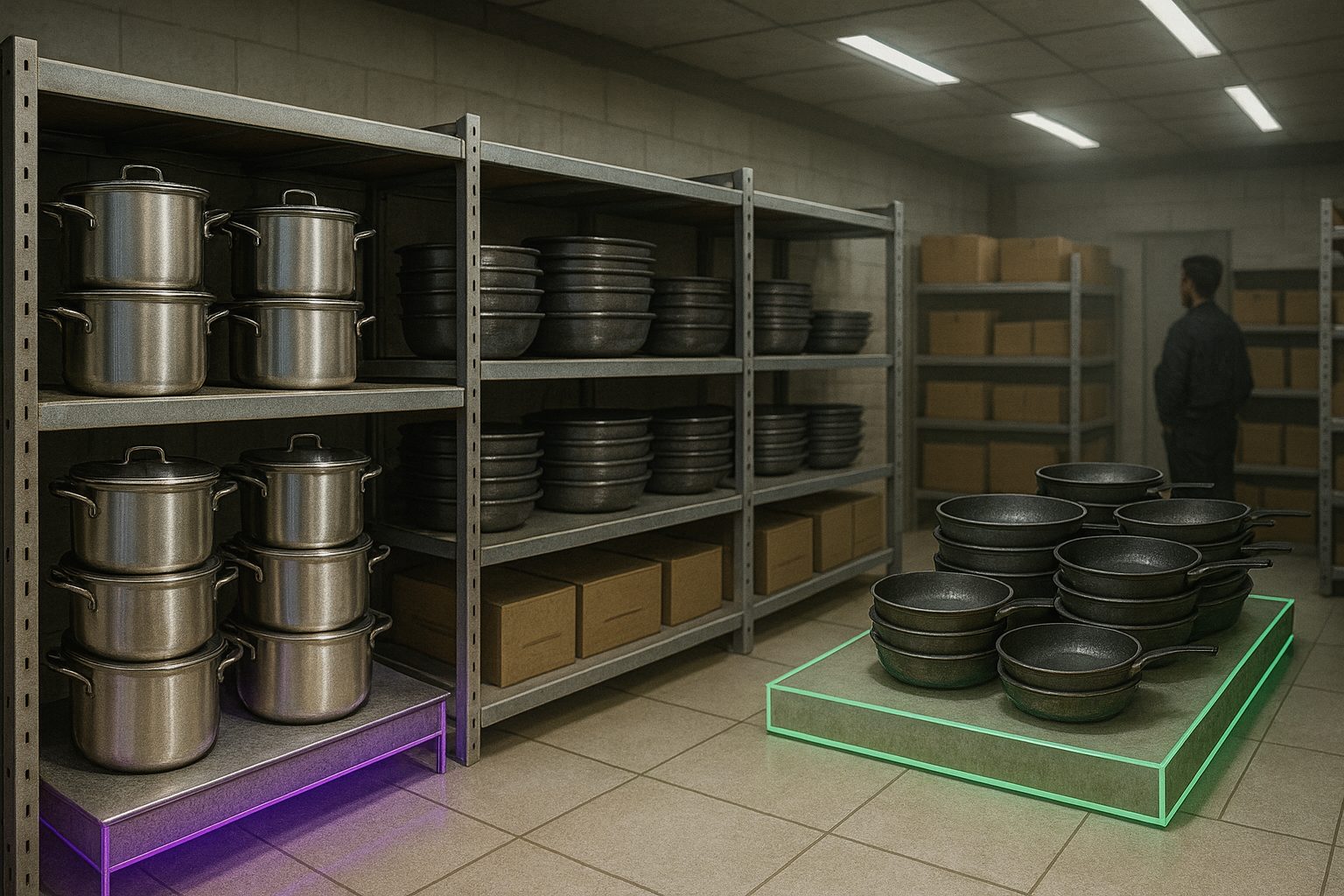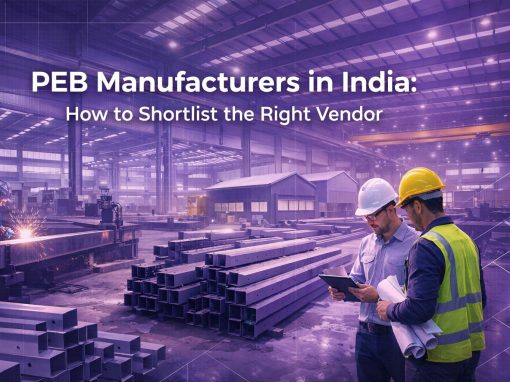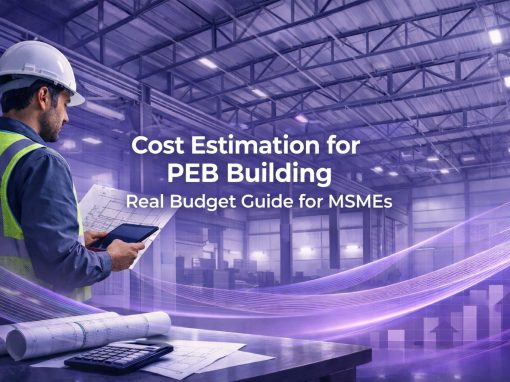Table of Contents
Introduction
Cookware choice is more than a kitchen decision. In commercial kitchens and food-service units, the material used directly impacts cooking quality, compliance, and overall business efficiency. For Indian MSMEs supplying to canteens, cloud kitchens, or institutional contracts, the debate between hard anodised and stainless steel goes beyond taste or appearance. It influences tender approvals, energy bills, and audit outcomes.
In real procuremen cycles, a wrong selection can create recurring challenges. Higher fuel usage, hygiene concerns, or tender rejections are common risks. Stainless steel remains the most recognised and audit-friendly option, while hard anodised aluminium is gaining traction for its quick heating and lighter handling.
To make the comparison clear, MSMEs need to focus on:
- How each material aligns with BIS and FSSAI compliance
- The total lifecycle cost, not just the upfront price
- Suitability for different cooking styles and bulk preparation needs
Let’s understand what these materials mean, compare performance and costs, and also highlight how to draft specifications that suppliers and auditors will accept. Apart from it, with this guide our aim is simple: give MSMEs a decision framework that saves money, avoids procurement friction, and secures long-term value.
What hard anodised and stainless steel actually mean
Understanding the basic difference between the two materials is the starting point for any procurement decision. Many MSMEs buy cookware on brand reputation alone, without checking the underlying specifications. That often leads to confusion during audits or tender evaluations.
Hard anodised aluminium
The making of hard anodised cookware involves treating aluminium through an electrochemical process. This creates a hardened surface layer that is darker in colour and more resistant to corrosion than plain aluminium.
For MSMEs, the advantages are clear:
-Faster heat conduction, making it suitable for high-volume cooking
-A non-porous surface (smooth surface) that resists sticking and mild scratches
-Lighter in weight, which makes handling easier in large and busy kitchens
That said, some caution and care is do required. If the coating is damaged, the exposed aluminium may react with acidic food. Recoating is not simple and often requires replacement.
Stainless steel
Stainless steel is an alloy, usually of iron with chromium and nickel, designed to resist rust and maintain strength. In food-contact use, it is graded according to Indian and international standards.
For MSME procurement, stainless steel brings:
-Long lifespan and strong resistance to dents or corrosion
-Compatibility with induction cooking and LPG lines
-Audit-friendly recognition under IS 5522 cookware standard and other BIS certifications
Also, multi-ply or tri-ply stainless utensils are also available, where a layer of aluminium or copper is sandwiched between steel sheets. This design improves heating performance while keeping the compliance advantages of stainless steel.
Why it matters for buyers
When raising purchase orders, MSMEs must specify whether the requirement is hard anodised aluminium or stainless steel, and if stainless, which grade or ply construction. Without this clarity, suppliers often send mixed lots, leading to disputes, quality complaints, or tender rejections.
Also read: How is cast iron cookware made? Manufacturing process, utensil cleaning tips
Compliance and food safety requirements in India
For cookware and utensils, compliance is never an afterthought. In India, it decides whether a shipment clears inspection or gets rejected. For MSMEs supplying to canteens, defence kitchens, or export buyers, this can mean the difference between repeat orders and cancelled contracts.
BIS standards that matter
The Bureau of Indian Standards (BIS) has put down two codes that are most relevant in this debate:
- IS 5522 for stainless steel sheets and strips used in utensils
- IS 1660 for aluminium utensils, including hard anodised types
Both standards specify thickness, finish, and test methods. They also demand that grades be declared clearly on paperwork. In real inspections, auditors check these codes first, often before looking at the cookware itself.
The FSSAI lens
The Food Safety and Standards Authority of India (FSSAI) brings in the health angle. Equipment touching food must be proven safe for acidic or oily preparations.
- Stainless steel, with the right chromium mix, is considered inert.
- Hard anodised aluminium is safe too, but only as long as the coating is intact. A chipped surface immediately raises questions.
Small firms often miss this detail. A missing certificate or an unclear grade declaration is enough for a tender committee to hold back payment.
Why MSMEs need to be careful
Tender notices usually include phrases such as “BIS certified” or “food-grade compliant.” These words carry weight. If the submission lacks proof, bids are disqualified, even if the product is otherwise functional.
For MSMEs, the safer approach is to:
- Attach BIS or equivalent certification copies with the bid
- Keep FSSAI-related declarations from suppliers ready
- Mention grade, standard number, and test method in the purchase order
These steps reduce inspection friction and give MSME bids a stronger chance of passing compliance checks.
Practical performance: Heat, durability, and safety
In commercial kitchens, paperwork may open the door, but performance keeps the contract alive. For MSMEs supplying to canteens or institutional buyers, the difference between hard anodised aluminium and stainless steel shows itself in day-to-day cooking, not in the brochure.
Heat and energy efficiency
Hard anodised aluminium conducts heat at remarkable speed. Pots reach working temperature within minutes, a clear advantage when hundreds of portions must move through the line quickly. Stainless steel takes longer, but once hot, it holds steady. That consistency is valued in dishes that need slow reduction or long simmering. Many bulk caterers now turn to tri-ply stainless, where an aluminium core gives speed while the steel surface satisfies auditors.
Durability under pressure
Stainless steel has a reputation for toughness. It resists dents, survives scrubbing, and rarely fails under heavy use. Hard anodised cookware is also resilient, yet its service life rests entirely on the coating. If the surface chips, the base aluminium is exposed, and replacement is usually the only option. For MSMEs working with thin margins, this can make stainless steel the safer long-term investment.
Safety in real cooking conditions
Everyday menus in India rely heavily on acidic bases — tomato gravies, tamarind broths, lemon rice. Stainless steel stays inert under these conditions, which is why inspectors rarely question it. Hard anodised vessels are safe too, provided the layer remains intact. A single crack, however, can raise compliance doubts and delay acceptance in government kitchens.
For a procurement head, these details translate directly into business outcomes. Faster cooking, reduced gas bills, fewer breakdowns, and audit comfort all flow from the material decision. That is why performance must be weighed as carefully as price.
Lifecycle cost and procurement considerations
For small businesses, the real expense is rarely the first invoice. It is the replacements, the downtime, and the inspections that follow. Cookware may look like a minor entry in the budget, but for an MSME running canteen contracts or supplying bulk orders, the wrong choice can drain margins.
Purchase versus service life
Stainless steel costs more upfront. Yet once bought, it usually stays in service for years. A stockpot can be scoured, buffed, and returned to duty. Hard anodised pans arrive cheaper but their life is tied to the coating. One deep scratch and the vessel is gone. In tender-driven supply, that difference matters. Buyers calculate not just cost per unit but the cost of replacement across the contract period.
Repairs and spares
Procurement managers prefer items that can be maintained. Stainless steel allows small fixes – new rivets, polishing, even welding if needed. Hard anodised vessels allow no such margin. If they fail, they must be swapped out. For an MSME serving multiple kitchens, sudden bulk replacements can strain both cash flow and supply schedules.
Tender scrutiny
Committees rarely look at brochures. They ask: will this utensil last the duration of the contract? Stainless steel, backed by IS 5522, clears that question without debate. Hard anodised aluminium under IS 1660 is valid too, but inspectors may probe more deeply, especially on lifespan. A missing certificate or unclear paperwork is enough to hold back payments.
Viewing cost over time
The better calculation is not cheapest today, but cheapest over five years. Stainless steel often wins on that count. Hard anodised has its place where speed and lightness are priorities, but MSMEs must treat it as a tactical buy, not the default choice.
Which material fits which MSME use case
The right cookware depends on where it will be used. A school canteen, a defence mess, or a delivery kitchen will not have the same needs. Therefore, the smarter choice for businesses is to link the material with the type of contract and cooking style. Let’s have a detailed understanding of the practical use cases of hard anodised vs stainless steel materials and gain better insights to which material is better.
Hard anodised vs stainless steel comparison
| Use Case | Hard Anodised Aluminium | Stainless Steel |
| Canteens and Institutional Kitchens | Heats fast and light to handle, but coating may not last long. Not always accepted in government kitchens. | Strong, long-lasting, and widely trusted. Certified under IS 5522, which auditors recognise. |
| Cloud Kitchens / Quick Service | Best for speed. Quick heating helps with fast turnaround. Needs more frequent replacement. | Takes longer to heat, but steady once hot. Useful for gravies or dishes that need simmering. |
| Bulk Food Processors | Not ideal for tomato, tamarind, or vinegar-based foods. Coating can wear off. | Safe for acidic recipes. Performs well on large LPG burners or steam setups. |
| Exports and Retail Supply | Possible if IS 1660 paperwork is complete. Often questioned by overseas buyers. | Easier choice for export. BIS and FSSAI compliance gives faster clearance. |
| Mixed Contracts | Quickly carried out for sauté or shallow frying however must be in smaller lots. | Stockpots, large vessels, and tender-based supplies are better in stainless steel. |
Key point for MSMEs:
One material does not fit all. Stainless steel is safer where audits and tenders are strict. Hard anodised works well for fast cooking tasks, but it is not a long-term option in heavy kitchens. Many MSMEs now use both – stainless for bulk work, anodised for speed.
Also read: Steel utensils: Business opportunities with kitchen utensils in India
Conclusion
MSMEs must note that the choice between hard anodised aluminium vs. stainless steel is not only about cooking results. However, it does affects audits, tender approvals, replacement costs, and client trust.
Stainless steel is the safer bet for long contracts, government canteens, and bulk food processing. Its durability, recognition under IS 5522, and resistance to acidic foods make it a dependable option. Hard anodised aluminium, on the other hand, offers quick heating and lighter handling, which suits cloud kitchens or quick-service outlets. Its drawback is a shorter service life and limited acceptance in strict audits.
The best approach is not to see them as rivals, but as tools for different needs. Stainless steel stockpots for heavy gravies and simmering. Hard anodised pans for fast frying or sauté work. This mix helps MSMEs control costs while meeting client expectations and compliance checks.
Looking to procure steel?
Tata nexarc helps manufacturers, builders and MSMEs source certified steel products, compare prices, and choose the right grade as per IS codes—with complete traceability and procurement confidence.
FAQs
Which material clears audits more easily, hard anodised or stainless steel?
Can hard anodised aluminium be used in government canteen tenders?
Which cookware lasts longer for bulk kitchen use?
Do MSMEs need to attach BIS certificates with tender bids?
Is hard anodised cookware suitable for acidic recipes like tomato or tamarind?
Which is more cost-effective over five years?
Can MSMEs export hard anodised cookware?
Which material works better on induction cookers?
How should MSMEs specify cookware in RFQs or purchase orders?
Can MSMEs mix stainless steel and hard anodised in the same supply order?
Charul is a content marketing professional and seasoned content writer who loves writing on various topics with 3 years of experience. At Tata nexarc, it has been 2 years since she is helping business to understand jargon better and deeper to make strategical decisions. While not writing, she loves listing pop music.
